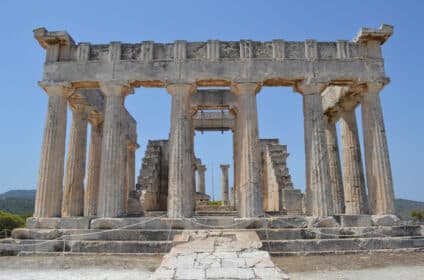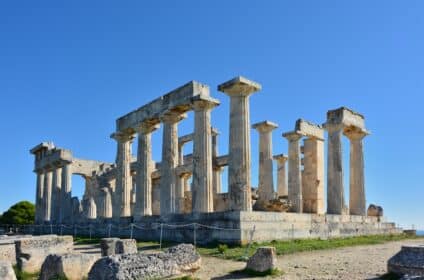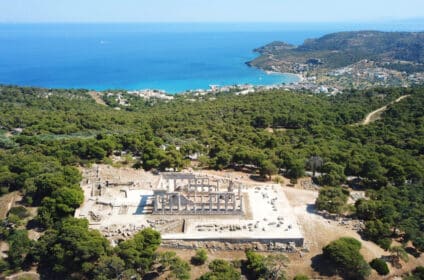Temple of Aphaia
- Viewed - 582
Description
The temple of Aphaia stands on a pine-clad hill in northeast Aegina. It is the most important monument in the sanctuary of Aphaia, which appears to have been founded on a site used for worship since the Mycenaean period. Pausanias (2, 30, 3-5) mentions the myth of Aphaia and identifies her with the Cretan divinity Britomartis-Diktynna, an opinion shared by modern scholars. The temple, erected at approximately 500-490 BC, replaced an earlier one, also of tufa, which stood on the same site and with the same orientation. This earlier Doric temple was built c. 570-560 BC and destroyed by fire in 510 BC. At the time of the construction of the new temple, the entire sanctuary was refurbished with new terraces, a stone enclosure wall and an imposing propylon on the south side, all of which contributed to its monumental appearance. Outside the propylon was a series of buildings, which served the needs of the sanctuary. Prosperity was not meant to last, however. The importance and infrastructures of the Aphaia sanctuary declined rapidly following the Athenian domination of Aegina from the middle of the fifth century BC. Some repairs were made in the fourth century, but the third century was a period of decadence and by the end of the second century BC the area was abandoned.
The temple is a Doric, peripteral hexastyle with twelve columns on the flanks. All the shafts are monolithic and fluted, except for three columns on the north side, which are built up of drums. The temple, which stands on a three-stepped crepis, presents the usual arrangement of pronaos, cella and opisthodomos. Both the pronaos and the opisthodomos are distyle in antis, while the cella is divided longitudinally by two rows of five columns each. A ramp of carefully cut stone rises to the crepis on the east side of the temple. The columns, cella walls and entablature were of local porous limestone, which was plastered and painted over. Traces of paint are still visible on the entablature. The two-sloped roof had terracotta roof tiles of the Corinthian type and a single row of marble tiles with palmette-shaped antefixes along the edges. The central, palmette-shaped acroterion, which was framed by two korai, and the four sphinxes on the corners of the roof were also of marble. The pedimental sculptures and the roof acroteria were of Parian marble and painted. The pediments depicted two mythical combats before Troy in the presence of Athena; heroes from Aegina participated in both. The east pediment showed the early expedition of Herakles against the Trojan king, Laomedon, in which Telamon, son of Aiakos, took part. The west pediment showed the later expedition by Agamemnon against Priam, in which three descendants of Aiakos, Ajax, Teukros and Achilles, participated. The west pediment reflects the aesthetics of the sixth century BC, while the east pediment, which is more animated and less stylized, dates to the early fifth century BC.
Administrative Information:
Ephorate of Antiquities of Pireus and Islands
Aphaia, Aigina (Prefecture of Attiki)
Telephone: +30 22970 32398
Fax: +30 22970 32398
Email: efapn@culture.gr
Tickets:
Full: €6, Reduced: €3
Amenities for the physically challenged:
Leaflet in Braille
Access:
Boat or Flying Dolphin from the port of Piraeus to the port of Aigina and then local bus to Aphaia.
Source: http://odysseus.culture.gr
Ephorate of Antiquities of Pireus and Islands
Gallery / Photos
Location / Contacts
- Address : Aphaia, Aegina
- Phone : +302297032398
- Mail : efapn@culture.gr
- Website : http://odysseus.culture.gr





